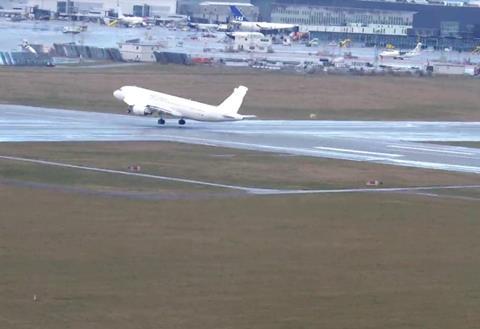Danish investigators have determined that an Airbus A320 crew’s aborting a landing, despite activating reverse-thrust, resulted in control difficulties as the aircraft climbed away with one engine’s reverser doors deployed.
Both pilots were aware that selecting reverse-thrust meant committing to land, but investigation authority Havarikommissionen states that each was “convinced” that the subsequent selection of go-around thrust would result in stowage of the reversers.
The TAP Air Portugal aircraft, inbound to Copenhagen from Lisbon on 8 April 2022, had conducted an approach to runway 30 in turbulence, rain and gusting conditions.
Tower controllers had requested that the A320 vacate the wet runway at taxiway D – a distance of 1,530m from the threshold – and the captain, who was flying, remarked to the first officer that this required full reverse-thrust.
The approach was stable and the thrust levers were retarded to idle during the flare, at about 10ft.

But the aircraft drifted slightly right of the centreline, then briefly banked 7.4° left. The left-hand main landing-gear made ground contact, with wheel spin-up, and as the aircraft started to de-rotate the crew activated maximum reverse-thrust.
The reversers began to deploy about 2s later when the engine control units on the CFM International CFM56 powerplants received a weight-on-wheels signal.
But the A320 bounced, momentarily cancelling the weight-on-wheels signal on the left-hand main gear. At the same time the captain – uneasy about the aircraft’s attitude – opted to abort the landing by advancing the thrust levers to go-around power.
Loss of the weight-on-wheels signal, at the moment the thrust levers were pushed forward, interrupted the stowing of the left engine’s reverser doors.
Although the right-hand main gear also lost its weight-on-wheels signal during the bounce, this occurred about 1s later, enough time to trigger reverser stowage on the right engine.
The inquiry states that, as a result, the aircraft began to climb away with its right engine spooling up to go-around thrust but its left engine still at idle, because its reverser doors were still deployed.
This asymmetric thrust presented the captain with “unanticipated difficulties” in controlling the aircraft.
It began to drift left of the centreline and the captain applied 55% of full right rudder during the climb.
“The unusual aircraft behaviour and lack of expected performance surprised the flight crew,” the inquiry states.

Analysis shows that the aircraft pitched 8.8° nose-up as it became airborne and passed the left-hand runway edge. At 1,600m beyond the threshold it was 65m left of the centreline, at a height of just 11ft, and ascending at a low rate of climb.
The crew understood the situation after the first officer observed a ‘reverser unlocked’ alert for the left-hand engine, and confirmed it was operating at idle thrust.
At a height of 300ft the captain declared an emergency, and the crew performed actions in response to the reverser alert, including shutting down the left engine, before carrying out a single-engined approach to runway 22L, where it landed safely.
None of the 102 passengers and seven crew members was injured. The aircraft’s left-hand reverser doors were found to be deployed after it arrived at its parking stand.
According to the inquiry the captain had previously experienced a similar situation in 2019, after activating reverse-thrust prior to applying go-around power.
Both engines’ reversers initially stowed, but one of the reverser doors on the left-hand engine unlatched at 100ft – opening slightly but remaining locked by the actuator.
Unlocking of the door did not result in a reverse-thrust scenario, says the inquiry. The engine control unit commanded idle thrust to protect the affected engine and the crew shut the powerplant down.
Owing to the low severity level of this earlier occurrence, no formal safety investigation was conducted, and no technical conclusion was reached regarding the unlatching.


























